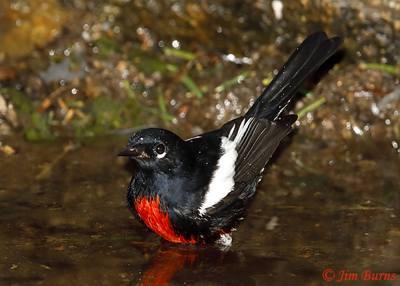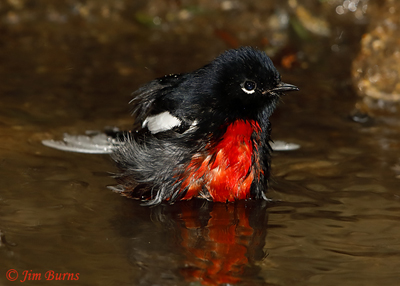
I had left home thinking thirteen warbler species were possible, not counting Olive which isn’t genetically in the warbler family despite its name, but including Hooded which may be established as a breeding species in the state now. Seeing thirteen would be one thing, but getting photographs, of course, would be an entirely different proposition. Warblers are active, and I wanted them bathing, an activity in which they feel especially vulnerable and thus engage more warily than anything else in their daily routine.
Other than Hooded, for which I knew the chances were next to nil, my real target was Painted Redstart simply because it’s such a spectacular little bird and one I had never yet seen at this waterhole though I knew it nested in the area. Over the next three days I was again tested by the birding gods and rewarded, not once, not twice as with the woodpecker, but with inexplicable third and even fourth chances. Over the course of a birding lifetime I’ve apparently paid a lot of dues.
But first, let me explain the two problems confronting me at the waterhole with which I did not have to deal at the woodpecker tree. The first is the waterhole sits below a spring emanating from a rock niche deep in a canyon under heavy, overhanging foliage. It’s dark in there. This requires using flash which doesn’t bother the birds, but it bothers me since I rarely use it because I find it hard to control and often dislike the way it renders the subjects. The second is the spring lies on national forest land leased by a rancher whose cattle had recently breached the fence put up by the forest service to protect the water source from degradation.
My notes say I spent seventeen hours at the waterhole over three days. That’s a lot of grinding but, you may recall, my Three-toed experience proved grinding can be rewarding. I was able to photograph a dozen warbler species, the only one missing being Virginia’s. They are the earliest migrants and had probably already departed. That dozen included both Hooded and Painted Redstart, but the latter required another smile from the birding gods who allotted me three do-overs this time.
Redstarts are early risers. In fact a nice adult was the first bird I saw on the first morning. It came in while I was still setting up, caught a few bugs near the water, then left. The only other redstart that day was a scruffy teenager with a few scarlet feathers poking through bushy, ugly gray plumage on its belly. No problem, right, because I figured the adult knew where the water was and would be back, I had two more mornings, and I was only thirty yards from my car, not two miles up a mountain.
Sure enough, on the second morning an adult came in and I was ready. It flipped around the foliage like an empidonax for a few minutes, catching bugs, then landed by the water, jumped in, and started splashing around as I triggered the shutter. Glancing down at my LCD screen, though, I didn’t see black, white, and scarlet. It was all black, the bathing bird totally underexposed. The batteries in the flash had run down from nearly continuous shooting on the first day. I had never before used the unit that much, or at least not enough to use up a set of batteries in one day.
You have probably guessed that rooting around changing batteries spooked all the birds away. No worries, though, because the adult knew where the water was and would be back, right? Absolutely, and when it came back I was ready again. Same sequence. Catch a few bugs, drop into the water, splash around while I fired away. But wait, the LCD was still all black. I wasn’t expecting the exact totally same sequence! Now this was a forehead smacker. When my camera body battery runs out, I stick in a new battery, the camera settings are unaffected, and I just start shooting again. With the flash unit, though, changing batteries requires reprogramming the settings. Again, if I’d done my homework, I’d have known that.
Alright then, new batteries and new settings, and I’m good to go for the rest of the day. You’ve undoubtedly guessed the adult redstart did not put in another appearance on this, my second day, but it knows where the water is, I have another day . . . hey, I know it will come in the next day because I remember back to my experience two weeks before with the Three-toed. Just gotta keep grinding. Besides, what else could go wrong, right?
On the third morning I was set up by the spring at the crack of dawn and, sure enough, an adult redstart came in around 9am. I was ready. Oh, by the way, have I mentioned the cattle? On my first day a couple small cows came in, but I was able to quickly shoo them away. On the second afternoon a herd came in, finally forcing me to abandon my position as even sticks and stones would not dissuade them from drinking.
Anyway, here’s my redstart bathing on the third morning, finally, and I take one shot, glance at the LCD screen out of habit, and see a gorgeous black, white, and scarlet image replete with water droplets splashing everywhere. When shooting bathing birds I typically shoot continuously, or nearly so (thus the need for several sets of fresh flash batteries), because every frame will be slightly different, a wing raised here, the tail spread there, a nictitaing membrane closed in the next one, nice ripples in the water on one.
So, I give a sigh of relief, and get ready to hold down the shutter button when I hear a large stick crack in the forest behind me followed by a crash. Yeah, redstart hears it too and immediately takes off. I feel sorry for that cow as I contemplate now how I must have looked and sounded charging it through the brush, screaming. Well, I needed to stretch my legs and get a little exercise anyway.
By now you’ve guessed the redstart did come back. One more time before I finally left, the bird more perseverant than the cows, but no more than I. The shots accompanying this column were all taken there at the waterhole in August. The moral of this story for birders is to be patient, keep grinding, pay your dues.